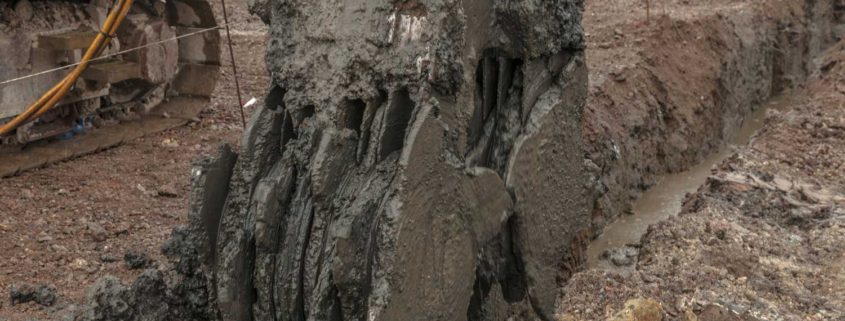Innovation in soil stabilisation through use of Cutter Soil Mixer
We saw a question on LinkedIn recently asking to what extent the Cutter Soil Mixer had been used in the UK and if soil mixing and the cutter soil mixer for retaining walls was a viable option for the UK. We thought we would answer that question and highlight how innovation in engineering can deliver solutions that are both cost effective and environmentally friendly as well as saving time on construction projects.
Deep Soil Mixing Ltd has used the Cutter Soil Mixer four times in the UK now over the last six years including the Mersey Gateway Bridge, Cheshire in 2016 where, after undertaking extensive soil mixing trials on behalf of Merseylink CCJV, we installed over 1800 panels at a number of locations across the north landside area of the Mersey Gateway project and these panels were designed to stabilise the ground in areas around the various bridge structures so that further construction work could be undertaken. Visit our case study page for more information
We also used the Cutter Soil Mixer on a retail park in Runcorn, where we installed soil mixed panels across the site as well as a soil mixed mattress and soil mixed wall next to a Major Accident Hazard Pipeline (MAHP), to lock in chemicals and prevent leachate to ensure the ground was stabilised for the building works to commence. During this project we installed a secant retaining wall which satisfied two functions (1) to retain a canal embankment and (2) assist in creating a plume stop for ground contaminants.
More information on the Runcorn retail park project can be found here.
We are currently using the cutter soil mixer on a housing project in Kent and have also recently used the Cutter Soil Mixer on a project at Dover Harbour.
Deep Soil Mixing Ltd has undertaken a wide variety of projects and have practical experience in the design and construction in a wide variety of soil mixed solutions from road construction through to dealing with contaminated and poor-quality ground, flood alleviation and slope stabilisation. We installed circular secant cells on the banks of the River Clyde for the Commonwealth Games Village project to stabilise and retain the embankment from further movement and also on the Manchester Ship Canal where rotational slippage was occurring..
We have used secant soil mixed columns as a sub-foundation on numerous projects.
We are becoming renowned for successfully undertaking challenging and difficult projects that others may not wish to do and can demonstrate the impact this is making in the world of civil engineering and illustrate how soil mixing techniques can transform severely contaminated or poor-quality land into commercially viable land that can be developed.
Our method of soil mixing remediates the soils in-situ. Using various binders for various applications we carry out soil mixing of the existing site soils to either produce large diameter stabilised columns, mass mixing for full depth treatment, mass mixing over the top of the columns to provide a transfer mattress, trench mixing to provide cut-off walls or even PRB walls, we do not remove materials from site, this has significant advantages of reducing CO2 emissions, improves sustainability and is recycling on a grand scale.
Soil mixing also reduces project times and costs as well as your carbon footprint on construction projects compared to other more traditional ground engineering methods such as various types of piling, excavate and cart away, dynamic compaction, surcharge etc. You are treating the ground in-situ and will not incur costly landfill charges.
If you have a project that has land that is contaminated or contains peat or if you want to improve the strength of weak soil and do not want to dig and cart away the ground please get in touch with us.






